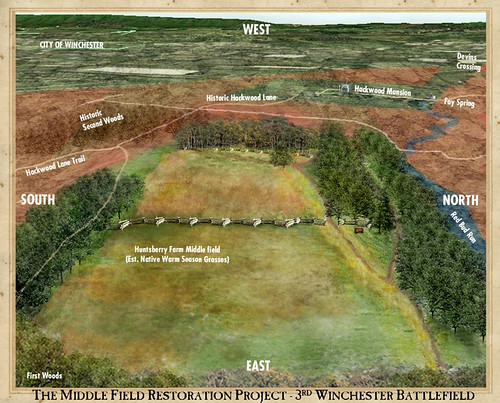
Three out of every five Civil War battles were fought in Virginia, so it should come as no surprise that some of the work of USDA’s Natural Resources Conservation Service (NRCS) is taking place on hallowed ground. In Winchester, Va., the agency is partnering with the Shenandoah Valley Battlefields Foundation to protect historic and natural resources on part of the Third Winchester Battlefield.
The foundation has discovered that keeping these sites in agricultural use is an economical way to maintain them. They have worked with NRCS since 2009 to preserve and conserve Huntsberry Farm, a 209-acre farm where cattle still graze today.
NRCS District Conservationist Mike Liskey helped Chase Milner, the foundation’s manager of stewardship, with conservation planning to address their concerns about water quality and invasive species while protecting vital cultural resources.
“Though this land falls into a special category, it is also in agricultural use,” Liskey said. “Cows in the creek are cows in the creek and it is a real resource concern whether it is a battlefield or not.”
NRCS, Trout Unlimited, and the Lord Fairfax Soil and Water Conservation District provided funds for a number of conservation practice that will lead to cleaner water on the battlefield lands and beyond.
Stream fencing will keep cattle out of Redbud Run, which flows into Opequon Creek, a tributary of the Potomac River and Chesapeake Bay. Cross fences installed for rotational grazing will help eliminate bare spots in pastures and promote more even distribution of manure to reduce runoff into nearby waterways.

“I cannot overstate the importance of our partnership with Mike Liskey and the NRCS,” said Denman Zirkle, the foundation’s executive director. “They provide technical support and funding that is essential to implementing best management practices on SVBF battlefields, including Third Winchester.”
The foundation also worked with the Virginia Department of Game and Inland Fisheries and NRCS to remove invasive species and plant native warm season grasses and wildflowers.
“They wanted to restore native grasses that were likely present at the time of the battle,” said Justin Folks, a wildlife biologist with Virginia Department of Game and Inland Fisheries. “As native grassland is scarce in the Shenandoah Valley today, this was a perfect opportunity to help wildlife species that require this habitat while meeting the preservation objectives of the SVBF.”
Much of the conservation work will be completed in time for the 150-year anniversary of the Third Battle of Winchester this September.
“It is a real privilege to work on these lands,” Liskey said. “When you stand beside a cannon emplacement and look at the surrounding urbanization, it’s hard to visualize what it was like 150 years ago. With our help, visitors will be able to more easily take that trip back in time.”




